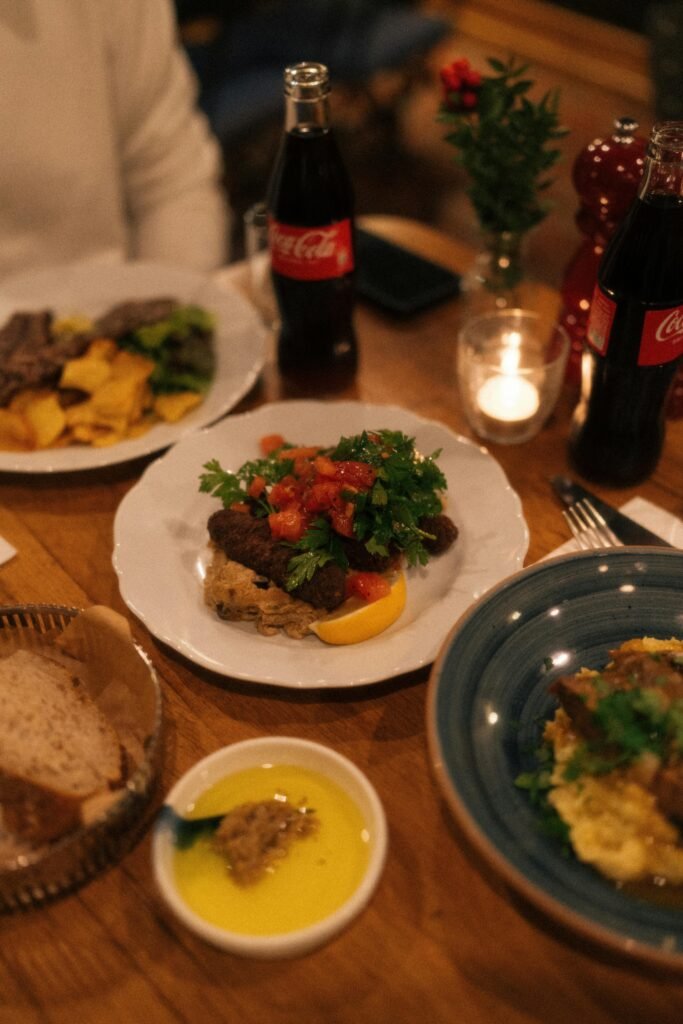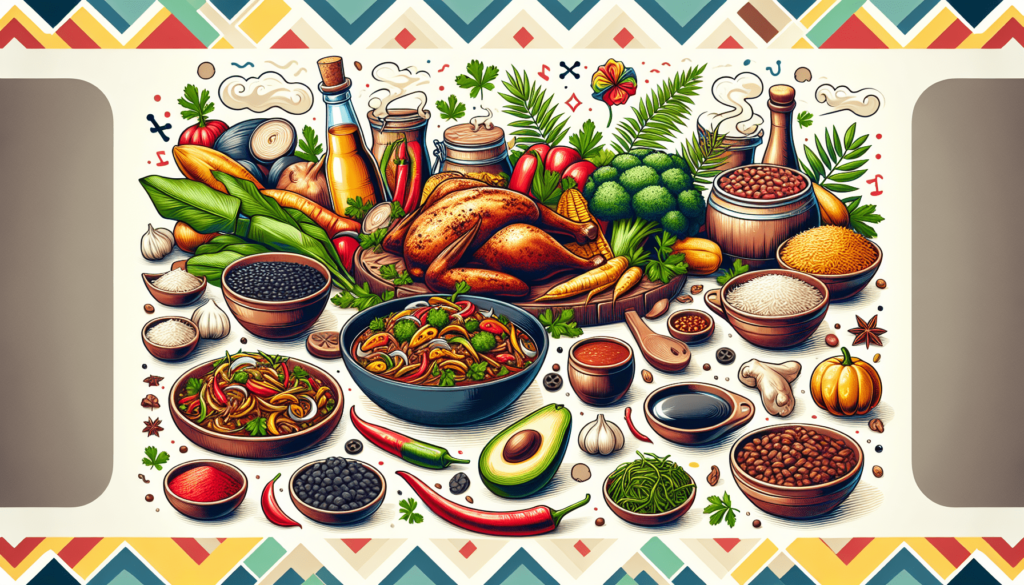Are you ready to embark on a culinary adventure through the flavors of the Caribbean? Look no further as this beginner’s guide will take you on a mouthwatering journey of cooking traditional Caribbean dishes. From aromatic spices to bold flavors, you will learn how to recreate authentic recipes that have been passed down through generations. Get ready to immerse yourself in the vibrant and rich culinary traditions of the Caribbean as you discover the secrets to cooking delicious island-inspired meals. So, grab your apron and let’s get cooking!
Introduction to Caribbean cuisine
Caribbean cuisine is a vibrant and diverse culinary experience that is loved and celebrated around the world. From the flavors of Jamaica to the spices of Trinidad, Caribbean dishes are known for their bold and exciting flavors. Whether you are new to Caribbean cuisine or looking to expand your culinary skills, this guide will provide you with an in-depth understanding of the ingredients, tools, techniques, and regional variations that make Caribbean cooking so special.
Key ingredients in Caribbean dishes
Caribbean dishes are known for their use of fresh and vibrant ingredients that bring out the flavors of the region. Some key ingredients commonly found in Caribbean dishes include tropical fruits such as mangoes, papaya, and guava, which add a burst of sweetness to savory dishes. Additionally, root vegetables like yams, cassava, and plantains are staples in many Caribbean recipes, providing a hearty and comforting base.
Seafood also plays a prominent role in Caribbean cuisine, thanks to the islands’ abundance of fresh fish and shellfish. From succulent shrimp to flaky snapper, seafood is often a highlight in dishes like fish escovitch, where the fish is marinated in a tangy blend of vinegar, spices, and onions.
Flavors and spices commonly used
When it comes to flavors and spices, Caribbean cuisine is a true melting pot. The region’s rich history of colonization and trade has influenced its culinary traditions, resulting in a unique blend of flavors from Africa, Europe, India, and indigenous cultures.
One of the most iconic flavors in Caribbean cuisine is jerk seasoning. A combination of allspice, thyme, Scotch bonnet peppers, and other spices, jerk seasoning is used to marinate meat, giving it a smoky and fiery flavor. Other popular spices in Caribbean cooking include cumin, coriander, turmeric, and cinnamon, which add layers of complexity to the dishes.
In addition to spices, Caribbean cuisine often incorporates tangy and citrusy ingredients like lime, lemon, and sour oranges. These acidic flavors help balance out the richness of the meat and seafood, creating a harmonious and well-rounded taste.
Basic kitchen tools
To embark on your Caribbean cooking adventure, there are a few basic kitchen tools that are essential for every home cook. These include a good set of knives for chopping and slicing ingredients, a cutting board, measuring cups and spoons for precision in your recipes, and a set of mixing bowls for preparation.
You’ll also need a reliable blender or food processor to puree sauces and marinades, a colander for draining grains and pasta, and a kitchen scale for accurate measurements. With these basic tools, you’ll be well-equipped to tackle any Caribbean recipe that comes your way.
Specialized Caribbean cooking utensils
In addition to basic kitchen tools, there are a few specialized Caribbean cooking utensils that can enhance your culinary experience. A mortar and pestle are commonly used in Caribbean cooking to grind spices and herbs, allowing you to release their full flavor potential. This traditional method of grinding spices not only adds authenticity to your dishes but also creates a beautiful aroma that will transport you to the islands.
Another important utensil is the wooden spoon, which is frequently used for stirring and mixing ingredients in Caribbean recipes. The wooden material helps prevent heat transfer, preserving the delicate flavors of the dish. Additionally, a cast-iron skillet is a must-have item for Caribbean cooking, as it helps achieve the perfect sear and even heat distribution.

Must-have pots and pans
When it comes to pots and pans, there are a few essential items that every Caribbean home cook should have in their kitchen. A large stockpot is great for making flavorful Caribbean soups and stews, while a deep-sided skillet or Dutch oven is perfect for slow cooking meats and vegetables.
Investing in a quality non-stick frying pan is also essential for sautéing ingredients without worrying about them sticking to the bottom. Finally, a grill pan or outdoor grill is a fantastic option for recreating the smoky flavors of Caribbean barbecue, such as jerk chicken or grilled fish.
Seasonal fruits and vegetables
Caribbean cuisine is deeply connected to the land and the sea, and as such, seasonal fruits and vegetables play a vital role in traditional dishes. The abundance of sunshine and fertile soil in the Caribbean results in a wide variety of fruits and vegetables that are both delicious and nutritious.
During the summer months, tropical fruits like mangoes, pineapples, and passion fruit are at their peak. These fruits can be enjoyed fresh, incorporated into salads, or even used as the base for refreshing fruit juices and smoothies. In the winter months, root vegetables like yams, sweet potatoes, and plantains take center stage, providing a hearty and comforting element to Caribbean dishes.
Commonly used meats and seafood
Meat and seafood are prominent ingredients in Caribbean cuisine, with a wide range of options to choose from. In some Caribbean islands, goat meat is highly regarded and commonly used in dishes like curry goat, where it is slow-cooked in a fragrant blend of spices and herbs.
Chicken is a popular protein choice, especially in dishes like jerk chicken, where it is marinated in a spicy blend of seasonings before being grilled to perfection. Seafood lovers will delight in the variety of fresh fish and shellfish available in the Caribbean, from snapper and mahi-mahi to lobster and conch.
Regional spices and herbs
Caribbean cuisine is famous for its bold and flavorful use of spices and herbs. Each island has its own unique combination of seasonings that sets it apart from the rest. In Jamaica, jerk seasoning is king, while Trinidad and Tobago are known for their vibrant and aromatic curry blends.
Other common spices and herbs used in Caribbean cooking include thyme, allspice, ginger, scallions, and garlic. These ingredients work together to create a symphony of flavors that dance on your taste buds, making every bite a memorable and delicious experience.
Jerk chicken
One of the most iconic and beloved dishes in Caribbean cuisine is jerk chicken. This flavorful and spicy dish originates from Jamaica and is made by marinating chicken in a blend of jerk seasoning, which typically includes allspice, scallions, thyme, garlic, and Scotch bonnet peppers.
After marinating for a few hours or overnight, the chicken is traditionally cooked over a grill or firewood, giving it a smoky and charred flavor. The result is tender and juicy chicken with a perfect balance of heat, sweetness, and spices.
Jerk chicken is often served with rice and peas, plantains, and a refreshing side of coleslaw or salad. It is an absolute must-try for anyone looking to explore the flavors of the Caribbean.

Roti
Roti is a traditional Indian flatbread that has been adopted and adapted by the Caribbean. It is a staple in Trinidadian cuisine and is commonly served alongside curries and other savory dishes. Roti dough is made by combining flour, water, and oil or ghee, which is then rolled into thin circles and cooked on a griddle or tawa.
There are different types of roti in Caribbean cuisine, including dhalpuri roti, which is filled with a flavorful split pea filling, and buss-up-shut roti, which is torn and resembles a tattered shirt. Roti is the perfect accompaniment to curried meat, vegetables, or even on its own as a snack.
Callaloo
Callaloo is a traditional Caribbean dish that has its roots in West Africa. It is a rich and hearty soup made with leafy greens, typically amaranth or taro leaves, and often combined with other vegetables like okra and pumpkin. Callaloo is a popular dish in many Caribbean islands, including Trinidad and Tobago, Jamaica, and Barbados.
The soup is flavored with aromatics like garlic, onions, and thyme, and often includes a protein component such as salted codfish or crab. Callaloo is simmered for hours, allowing the flavors to meld together and create a comforting and nourishing dish that is enjoyed year-round.
Ackee and saltfish
Ackee and saltfish is widely considered the national dish of Jamaica and is a quintessential Caribbean breakfast. Ackee is a tropical fruit that, when cooked, takes on a texture similar to scrambled eggs. It is usually sautéed with salted codfish, onions, and peppers, and seasoned with thyme and other aromatic spices.
This savory and flavorful dish is often served with fried plantains, dumplings, and boiled green bananas. The combination of the creamy ackee, the saltiness of the fish, and the aromatics make for a truly delightful and satisfying meal.
Plantains
Plantains are a staple in Caribbean cuisine and are often referred to as the “vegetable banana.” These starchy fruits resemble bananas and can be prepared in a variety of ways, depending on their ripeness. When green or unripe, plantains are used in savory dishes where they lend a potato-like texture and flavor.
Green plantains can be boiled, fried, or mashed to make dishes like tostones or mofongo. As plantains ripen and turn yellow or black, they become sweeter and are used in desserts like sweet plantain tarts or simply eaten ripe and raw. Plantains are incredibly versatile and can be enjoyed in both sweet and savory applications.
Curry goat
Curry goat is a beloved dish in Caribbean cuisine, particularly in Jamaica and Trinidad. This flavorful and hearty dish is made by marinating goat meat in a blend of curry spices, including turmeric, cumin, coriander, and fenugreek, among others. The meat is then slowly cooked until tender and served with rice and peas or roti.
Curry goat is a dish often enjoyed on special occasions and gatherings, as it can take several hours to achieve the desired tenderness. The bold flavors and aromatic spices make it a true delight for the taste buds, leaving you wanting more with every bite.

Rice and peas
Rice and peas is a staple dish in Caribbean cuisine and is often considered the heart of many meals. Contrary to its name, rice and peas are made with kidney beans and not green peas. The dish is made by cooking rice with coconut milk, kidney beans, onions, garlic, thyme, and Scotch bonnet peppers.
The result is a fragrant and flavorful side dish that pairs perfectly with any Caribbean main course. Rice and peas are often served alongside jerk chicken, curry goat, or stewed fish, making it a versatile and essential component of Caribbean cuisine.
Coconut rice
Coconut rice is a simple yet delicious dish that perfectly embodies the flavors of the Caribbean. Made by cooking rice with coconut milk, the dish is rich, creamy, and packed with tropical flavors. Coconut rice can be enjoyed on its own or as a side dish to complement curries, stews, or grilled meats.
To add an extra layer of flavor, you can also sauté the rice with onions, garlic, and spices before adding the coconut milk. The end result is a fragrant and silky rice dish that will transport you to the beautiful beaches of the Caribbean.
Sorrel
Sorrel is a popular Caribbean drink that is enjoyed during the festive season, particularly around Christmas time. It is made from the sepals of the sorrel plant, which are bright red and have a tart and tangy flavor. The sepals are steeped in boiling water along with spices like cloves, ginger, and cinnamon, and sweetened with sugar.
The resulting drink is often served chilled and is incredibly refreshing, making it a perfect accompaniment to heavy holiday meals. Sorrel is also sometimes spiked with rum to add an extra kick and festive spirit.
Marinating and grilling
Marinating and grilling are two cooking techniques that are heavily used in Caribbean cuisine. Marinating allows the flavors to penetrate the meat or seafood, resulting in a more flavorful and tender dish. Traditional Caribbean marinades often contain a variety of spices, herbs, and citrus juices, which help to tenderize the protein while infusing it with flavor.
After marinating, the ingredients are then grilled over an open flame or on a barbecue, giving them a smoky and charred flavor. Grilling adds a unique dimension to Caribbean dishes, elevating the flavors and providing a delicious caramelized crust.
Slow cooking and stewing
Slow cooking and stewing are methods commonly used in Caribbean cuisine to create rich and flavorful dishes. These techniques are perfect for tougher cuts of meat like goat or beef, as the low and slow cooking process helps break down the collagen and create a tender and melt-in-your-mouth texture.
Stews are made by simmering the ingredients in a flavorful broth, allowing the flavors to meld together and develop over time. This results in a hearty and comforting dish that is perfect for cool evenings or gatherings with friends and family.

Steaming and boiling
Steaming and boiling are cooking methods often used for vegetables and seafood in Caribbean cuisine. Steaming retains the nutrients and vibrant colors of the vegetables, while boiling is great for quick and efficient cooking.
Steamed vegetables like callaloo or okra add a fresh and crunchy element to Caribbean dishes, while boiled seafood like shrimp or lobster are often enjoyed on their own or added to stews and soups. These cooking techniques are simple yet effective, allowing the natural flavors of the ingredients to shine.
Frying and sautéing
Frying and sautéing are cooking methods that add a delicious crispy texture to many Caribbean dishes. From fried plantains to crispy chicken, these techniques are used to create both savory and sweet delights.
Frying is often done in a neutral oil like vegetable or canola oil, while sautéing incorporates the use of aromatic ingredients like onions, garlic, and peppers for added flavor. These cooking methods are perfect for achieving that satisfying crunch and adding depth to your Caribbean culinary creations.
Sweet and savory balance
One of the defining characteristics of Caribbean cuisine is the balance between sweet and savory flavors. Many traditional dishes successfully combine these contrasting tastes to create a harmonious and complex flavor profile.
For example, jerk chicken is renowned for its spicy and smoky flavors, which are balanced by the sweetness of the marinade and the tropical fruits used in the dish. Similarly, rice and peas incorporate both the savory elements of the beans and the sweetness of the coconut milk, creating a well-rounded and satisfying side dish.
Spicy and tangy profiles
Caribbean cuisine is known for its love of spicy and tangy flavors. Scotch bonnet peppers, one of the hottest peppers in the world, are commonly used in Caribbean cooking to add a fiery kick to dishes. The heat from the peppers is often balanced by tangy ingredients like lime or vinegar, which help to cut through the spiciness and add brightness to the dish.
Whether it’s the tangy jerk marinade or the spicy pepper sauce accompanying a meal, the combination of heat and acidity is a hallmark of Caribbean cuisine that keeps you coming back for more.
Adding depth with herbs and spices
Herbs and spices are the secret ingredients that elevate Caribbean dishes and add complexity to flavors. Fresh herbs like thyme, cilantro, and parsley are commonly used to add a vibrant and aromatic element to Caribbean cooking.
Spices like allspice, ginger, and cinnamon are also key players in creating depth and richness. These ingredients are carefully combined to strike a balance that enhances the natural flavors of the meat, seafood, and vegetables, creating a truly unforgettable taste experience.

Properly washing and cleaning ingredients
Properly washing and cleaning ingredients is an essential step in Caribbean cooking. This not only removes any dirt or impurities but also helps ensure that your dish is fresh and safe to consume.
Before cooking, ensure that you thoroughly wash fruits, vegetables, and herbs under running water. Gently scrub the skin with a produce brush to remove any dirt or residue. For leafy greens, such as callaloo or spinach, soak them in water and swish them around to dislodge any sand or grit.
Marinating for enhanced flavors
Marinating is a technique that allows the flavors to penetrate the meat, seafood, or vegetables, resulting in a more flavorful and tender dish. To maximize the flavors, it is best to marinate your ingredients for at least a few hours or overnight.
In Caribbean cuisine, traditional marinades often contain a combination of spices, herbs, citrus juices, and some form of oil to help the flavors meld together and infuse the ingredients. As a general rule, the longer you marinate, the more pronounced the flavors will be.
Knife skills and chopping techniques
Knife skills and chopping techniques are essential for achieving consistent and even cuts in Caribbean cooking. Properly chopped ingredients not only ensure even cooking but also enhance the presentation of the dish.
Start by selecting a sharp chef’s knife and hold it firmly in your hand. Always make sure the knife is steady and controlled, keeping your fingers away from the blade. Practice different chopping techniques, such as mincing, dicing, and julienning, to become more proficient in your knife skills and elevate your culinary creations.
Jamaican cuisine
Jamaican cuisine is known for its bold and vibrant flavors. Some iconic dishes in Jamaican cuisine include jerk chicken, curry goat, and ackee and saltfish. Jamaican cuisine is heavily influenced by West African, European, and Indian flavors, resulting in a rich and diverse culinary tradition.
Trinidadian cuisine
Trinidadian cuisine is a fusion of Indian, African, Chinese, and European influences. The diverse population of the island has contributed to the unique and flavorful dishes found in Trinidadian cuisine. Popular dishes include roti, doubles, and pelau, which represent the richness and diversity of Trinidadian culinary traditions.
Cuban cuisine
Cuban cuisine is characterized by its simplicity and use of local ingredients. The flavors of Cuban cuisine are largely influenced by Spanish, African, and Caribbean influences. Classic Cuban dishes include ropa vieja, moros y cristianos, and lechon asado.
Haitian cuisine
Haitian cuisine is a rich and flavorful culinary tradition that reflects the country’s African, French, and Taino heritage. Haitian dishes often feature hearty ingredients like root vegetables, beans, and seafood. Popular Haitian dishes include griot, diri ak djon-djon, and pikliz.
Puerto Rican cuisine
Puerto Rican cuisine is a melting pot of flavors, combining indigenous, African, Spanish, and American influences. The island’s cuisine is known for its bold and savory flavors, with dishes like mofongo, arroz con gandules, and pernil being staples in Puerto Rican households.
Adapting traditional dishes
For those looking for vegetarian or vegan options, traditional Caribbean dishes can easily be adapted to suit dietary preferences. Many Caribbean ingredients, such as plantains, yams, and beans, are naturally vegetarian or vegan-friendly, making it simple to create flavorful plant-based meals.
For example, traditional dishes like curry goat or jerk chicken can be made with plant-based protein alternatives, such as seitan or jackfruit, to replicate the flavors and textures of the original dish. Additionally, incorporating a wide variety of vegetables, legumes, and grains into your meals will create a nutritious and satisfying dining experience.
Replacing meat with plant-based alternatives
As the popularity of plant-based diets increases, there are now an abundance of meat replacements available that can be used in Caribbean cooking. Jackfruit is a versatile fruit that can be shredded and used as a substitute for shredded meat in dishes like jerk chicken or curry goat.
Additionally, seitan, made from wheat gluten, can be flavored and cooked to resemble the texture and taste of meat. By experimenting with these plant-based alternatives, you can create delicious and satisfying Caribbean dishes that cater to a variety of dietary preferences.
Creative use of vegetables and legumes
Vegetables and legumes play a prominent role in Caribbean cuisine, and there are countless creative ways to incorporate them into your dishes. Utilize the vibrant flavors and textures of vegetables like okra, eggplant, and pumpkin to add depth and variety to your meals.
Legumes like beans and lentils are also great additions to Caribbean dishes, providing a good source of protein and fiber. Whether it’s adding black beans to rice and peas or incorporating lentils into a hearty curry, the possibilities are endless for creating delicious and nutritious vegetarian and vegan Caribbean dishes.
Importance of fresh ingredients
Fresh ingredients are at the heart of Caribbean cooking. The vibrant flavors and aromas that are synonymous with Caribbean cuisine can only be achieved with the use of fresh, high-quality ingredients.
When shopping for ingredients, prioritize locally sourced produce and seafood, as they are often fresher and more flavorful. Take the time to select ripe fruits and vegetables that are in season, as they will provide the best taste and texture to your dishes.
Exploring local markets
One of the best ways to truly experience Caribbean cuisine is to explore local markets. These vibrant hubs of culinary activity offer a treasure trove of fresh produce, herbs, spices, and regional specialties.
Take the time to wander through the aisles, interact with local vendors, and discover new and unique ingredients. Exploring local markets not only gives you the opportunity to support local businesses but also allows you to immerse yourself in the sights, sounds, and flavors of Caribbean culture.
Authentic cooking techniques
To achieve authentic Caribbean flavors, it is important to familiarize yourself with traditional cooking techniques. Take the time to learn how to properly use a mortar and pestle to grind spices, as this will release the full flavor potential of the ingredients.
Additionally, mastering the art of slow cooking and stewing will help you achieve the tender and flavorful dishes that are synonymous with Caribbean cuisine. By using these authentic cooking techniques, you can ensure that your dishes capture the essence and spirit of the Caribbean.
In conclusion, Caribbean cuisine is a culinary adventure filled with vibrant flavors, bold spices, and innovative techniques. By understanding the key ingredients, tools, techniques, and regional variations, you can embark on a journey to master the art of Caribbean cooking. Whether you’re indulging in a plate of jerk chicken or savoring a bowl of callaloo, each bite will transport you to the sunny beaches and breezy landscapes of the Caribbean. So gather your ingredients, sharpen your knives, and get ready to create mouthwatering dishes that capture the true essence of this cherished cuisine.


